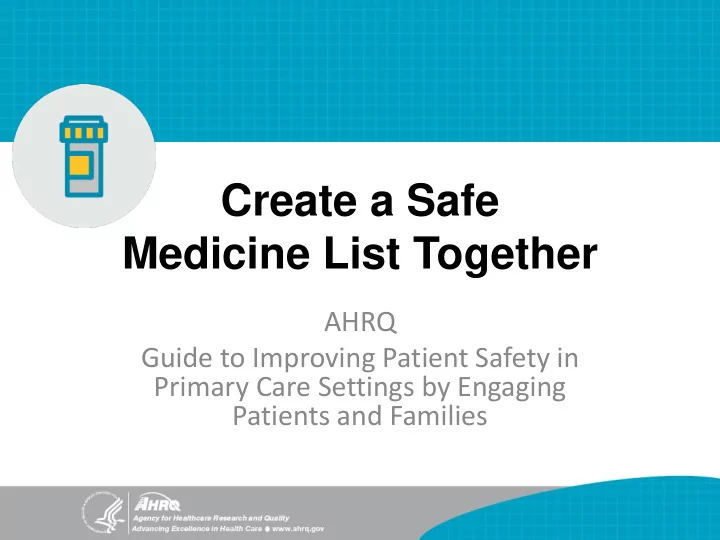

Create a Safe Medicine List Together AHRQ Guide to Improving Patient Safety in Primary Care Settings by Engaging Patients and Families
What is it?
Why is it important? 3.2 billion 2/3 of primary ordered or prescribed care visits involve medicines 160 million of those result in error For patients on 5+ medicines , 57% are not needed , are contraindicated, or are not taken as prescribed
How can it help me? • Results in a complete and accurate medicine list • Reduces medicine errors • Offers the opportunity to reduce the number of prescribed medicines • Improves the clinician and patient relationship
When should I use it? • List the target patient populations here. Customize this slide to match your practice's implementation strategy.
How do I use it? • Requesting patients bring in medicines • Reminding patients to bring in medicines • Creating a safe medicine list together • Documenting the list in the EHR • Reviewing and reconciling the list • Updating the EHR Customize this slide to match your practice's implementation strategy.
What tools are available?
Scenario 1 • Mr. Thomas – 78-year-old male with uncontrolled hypertension and knee pain • Lifts weights, walks often, rides stationary bike • Visiting for knee pain that is keeping him from exercising • EHR lists: — Hydrochlorothiazide 50 mg – 1 tablet PO QD. — Atorvastatin 20 mg – 1 tablet PO QD. — Low-dose adult aspirin 81 mg – 1 tablet PO QD.
Scenario 2 • Mrs. Martin – 63-year-old female following up after reconstructive surgery for fractured skull from a fall • Struggling with depression after loss of father and sister • EHR lists: – Citalopram 20 mg PO QD. – Vitamin D 1,000 mg PO QD.
Scenario 3 • Ms. Santiago – 46-year-old female following up after MI and placement of drug-eluting stent in RCA through angioplasty • Discharged from hospital 4 days ago • Unremarkable medical history prior to MI • EHR lists: – Vitamin D 1,000 mg – 1 tablet PO QD.
How will we evaluate it? • Adverse drug events • Unsafe medicine issues Customize this • Medicine adherence slide to match • Satisfaction your practice’s implementation • Reported use strategy. – Bring in medicines. – Create safe medicine list together.
Recommend
More recommend